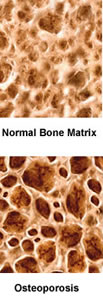Bone Deep

--Sue McDonald
Learn how to keep bones healthy even if cancer treatment has increased your risk for osteoporosis
The results of Susan McDonald's bone mineral density screening were troubling. Bone density had decreased 3 percent in her spine and 3.6 percent in her hips since a scan done two years earlier. Given her history of breast cancer and the potential that related treatments might further sap her bones strength, McDonald needed a plan to improve her bone health.
Her oncologist, Catherine Van Poznak, M.D., outlined some options to address the thinning in her bones, which in the case of her hips had progressed to a precursor of osteoporosis called osteopenia. McDonald, a 72-year-old Ann Arbor resident, decided to make a concerted effort to increase her walks from 20 minutes to 30 minutes per day, covering about a mile-and-a-half to a mile-and-three-quarters during each outing.
Two years later, McDonald's bone mineral density was much improved.
"I'm a small, fine-boned woman who's likely to get in trouble with bone problems," McDonald said. "But they were talking about osteopenia in my hips two years ago; they're not saying that anymore."
Bone health may be of particular concern for people with a history of cancer, said Van Poznak, a University of Michigan Rogel Cancer Center oncologist who specializes in breast cancers relationship to bone. People with breast or prostate cancer who undergo treatments that block specific hormones may be at higher risk of thinning bones. Also, certain chemotherapy drugs used to treat these or other cancers may induce ovarian failure in younger women, causing bones to thin as a result of early menopause and estrogen deprivation. In addition, steroids may also accelerate bone loss in both men and women.
Although cancer treatment may increase the likelihood of developing osteoporosis -- which may lead to painful bone fractures -- many options are available to prevent it, Van Poznak said. The key is to talk to your doctor early to develop a plan of action. Here are six steps you can take to improve your bone health.
Talk with your doctor about your risk of osteoporosis. You may be at higher risk depending on your family history, diet and whether you have ever smoked. Women older than 65 and men older than 70 are generally at higher risk. White people also seem to have an increased risk.

A bone mineral density screening may be right for you, depending on your risk factors. An X-ray of your hip, lower spine and wrist will help establish your risk of fracture and guide your doctor in planning any follow-up treatment that may be necessary. Several medications are now available to treat osteopenia and osteoporosis. Some of these drugs -- bisphosphonates and denosumab -- are being studied in clinical trials to see if they can help to prevent cancer from spreading to the bones. These same drugs are used to decrease the risk of fractures when cancer involves the bones. When used to treat bone metastases, the dose and schedule of these drugs is more intensive than when treating osteoporosis.
Consider a vitamin D supplement. Vitamin D also plays a vital role in bone health and is often not as readily available in an average diet, unless you drink fortified milk or orange juice. Most people need between 400 IU and 800 IU per day.
Add weight-bearing exercise to your routine. Gravity helps encourage bones to become denser at areas that support weight, so make sure you incorporate weight-bearing exercise into your workouts. Walking is an excellent option, particularly when carrying hand weights.
Avoid tobacco and alcohol. Tobacco use and excessive alcohol consumption have both been associated with bone loss.
Get your daily dose of calcium. Recommendations vary based on age, but most people need between 1000 mg and 1200 mg per day of calcium. Ideally, calcium is consumed as part of a well-balanced diet that includes dairy products rich in calcium. However, many people benefit from the use of supplements. Calcium is best absorbed in portions of 400 mg to 600 mg at a time, so plan to take it in divided doses throughout the day.
Keeping cancer out of the bone
Research Spotlight
Evan Keller, D.V.M., Ph.D., a professor of urology and co-director of the Prostate Oncology Program at the University of Michigan Rogel Cancer Center, is working with several other researchers to examine why prostate cancer spreads to the bones. The goal of their work is to develop drugs that can interfere with the biological processes that cause bone metastasis.
The team has already had some success: Keller's group conducted early laboratory studies on denosumab, a drug now known commercially as Xgeva, that prevents bone fractures and other skeletal conditions in people with breast and prostate cancer that has spread to the bone. The drug alleviates bone pain and decreases the need for pain medication.
"If we can prevent cancer cells from getting into the bone, we could enhance cancer patients' quality of life," Keller said. "If we can slow down cancer's growth and slow down bone destruction, we can increase survival."
Bone Health Resources
We put together a list of resources which provide excellent information on osteoporosis and cancer survivors
- Bone and Cancer Foundation
- National Institutes of Health: What Breast Cancer Survivors Need to Know about Osteoporosis
Read the Summer, 2011 issue of Thrive
